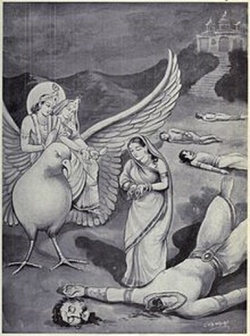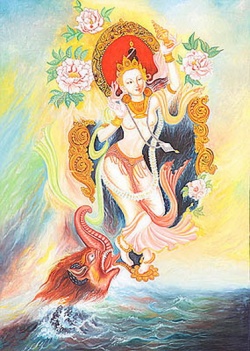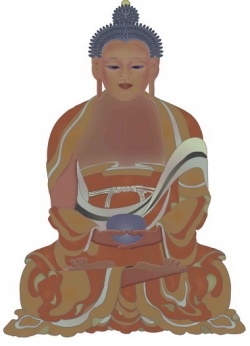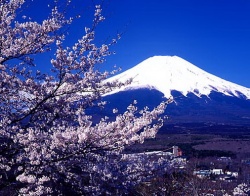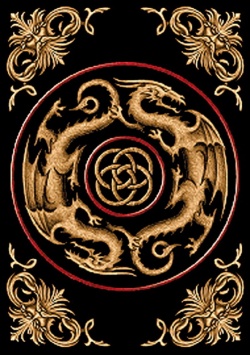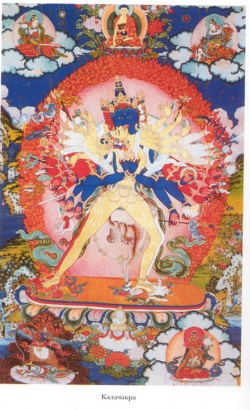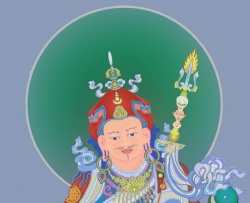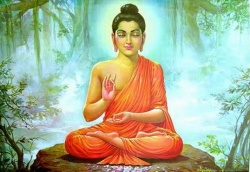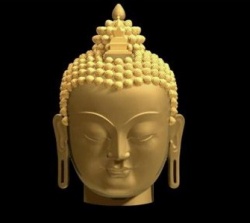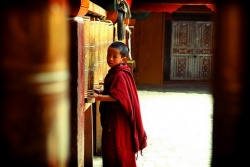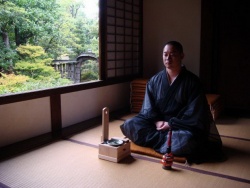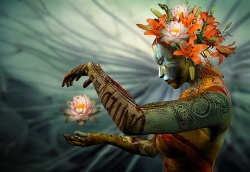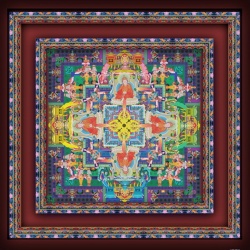The Dance of the Self-Beheading Woman
The Dance of the Self-Beheading Woman: Death
and Mutilation in the Tibetan Hermeneutics of the
Feminine
by John Wu
The Self-beheading Woman in the Charnel Ground: The Rite of Chod With a sudden shout of the mystic syllable 'phat!', the yogini, sitting cross-legged on the ground, visualised self-beheading. The visualisation continued with the placing of her own head in a cauldron, before she then proceeded to cut up the rest of herself; her body parts and entrails were placed in the same cauldron. The whole act was performed without the slightest trace of attachment or sentimentality; the fragments of her body were now ready for devouring by the many wrathful spirits who had already gathered around her as a result of her invoking them earlier in the ritual.
The yogini practiced this on her own, deliberately choosing a place that would normally be regarded as frightening and haunted, such as the charnel ground where corpses were cut up and fed to vultures and wild dogs as part of what were known as 'sky burials'. The darkness of night was preferred too. Highly charged chanting, the accompaniment of the hand-held damaru drum and the blowing of a long horn fashioned from a human thigh bone were the external aspects of this rite which, on the surface, revelled in death and the demonic.
Of course, the yogini's head remained well and truly on her body, which was still intact. What had just been cut up, without remorse, was the fictional body of her ego, which the ordinary human mind, subject to habitual samsiiric delusion, has the habit of taking to be real. Her aim was tantric: it involved the cutting through and the resultant disintegration of the conventional figuration of herself, thus allowing for the emergence of the 'clear light' (prabhasvara, prabhiisal rab tu snang ba) of her non-dual, primordial mind.
The experience is one of gnosis and is the manifestation of enlightenment, the ultimate potential in every woman and man. With the emergence of this clear light came the dissolution of all the pleasant and unpleasant images and sensations that had gone through her mind during this 'self-mutilating' rite. In this way, and with this self-understanding, the yogini's existential The Dark Side experience entered the supreme level known as 'one taste' (ekarasal ro gcig). We are in eleventh century Tibet, during the monumental period of the second transmission of Buddhism from India.
We are probably in the year 1092, for it was at this time, in the thirty-seventh of her long life of ninety-nine years, that a wandering female meditator named Machig Labdron began working directly with dakinis in order to transmit esoteric teachings that were, at least in theory, based on orthodox Buddhist philosophy;l however, in practice, they were a combination of shamanism and tantra. So effective were Machig Labdron' s teachings that her students came to include learned lamas and members of the nobility. She was, moreover, able to start an independent spiritual movement known as chod (gcod) which literally means 'cutting through' or 'cutting down'.
Hagiographical sources indicate that when Machig Labdron was forty-one years old, she received direct empowerment from Tara, the female Buddha, who appeared to her surrounded by a retinue of dakinis while she was staying in a cave on retreat. Chod remains a significant stream within Tibetan spiritual life till this day; its apparent heterodoxy from traditional monastic Buddhism was tolerated largely because it worked well within the greater context of the Buddhist tradition as a whole, especially when it later came to be incorporated into the originally Indian anuttarayogatantra ('Highest Yoga Tantra') which crowns the esotericism of Tibetan Buddhism.3
Yet chod, as a genuine and autonomous ma brgyud ('female lineage') has been, and still is, regarded as problematic by many monks from the dominant orthodoxy of the Gelug (dGe lugs) 1 I take these as Machig Labdron's dates following Jerime Edou, Machig Labdron and The Foundations of Chod, Snowlion Publications (Ithaca, 1996) pll0. 2 Ibid, p150. Edou's translation of excerpts from Phung po gzan skyur gyi rnam bshad gcod kyi don gsal byed. 3 lbid pp37-40. The great rime or non-sectarian lama Jamgon Kongtrul Lodro Thaye enthusiastically equated Machig Labdron's chod teaching to mahamudra ('Great Seal'), the supreme practice in the Highest Yoga Tantra.
He effectively endorsed Machig Labdron as an enlightened teacher and her chad as an adequate path to liberation in its own right. Here, it is important to note that the first Buddhist tradition of Tibet, Nyingma, calls its highest form of tantra atiyoga, not anuttarayoga; instead of the Great Seal, it has dzogchen ('Great Perfection'). Many dzogchen practitioners practice chod too. Nam kha'i Norbu Rinpoche, a contemporary dzogchen master based in Italy, is an advocate of this tradition. The Self-Beheading Woman: Tibetan Hermeneutics of the Feminine order, which in the 1930s tried to ban its practice altogether in its monasteries.
These beneficent otherworldly beings known as dakinis which I have just mentioned (who played an essential role in the spiritual maturation and attainments of Machig Labdron as we already seen), are very popular in the Tibetan imagination. The dakinis ' blessings and assistance are vital to the growth and success of the serious adherent's practice. l)iikinis are always female in appearance and although they can appear in either attractive or fearful forms in Tibetan Buddhist art, they are more often iconicized as beautiful naked maidens. All women, despite the lowly socio-political and religious status they were accorded in traditional Tibet, were viewed as qiikinis, either in essence or in disguise, by men with spiritual wisdom.
In a sense, this is in keeping with tantric practice which forbids the disparaging of women. Recent feminist critiques of Tibetan Buddhism, however, have pointed out that despite tantra's espousal of the (theoretical) spiritual superiority of women, qakinis were, and still are, mainly used by male tantric practitioners to bring about the rapid acceleration of attainment through the secret practice of kamamudra ('sexual yoga') which transforms ordinary passion into mahasukha ('great bliss'). Although Tibetans acknowledge that the consorts of lamas and yogis can also attain enlightenment, the patriarchal structure and organization of Tibetan Buddhism, feminists argue, exclude feminine subjectivity (in the holistic sense of unitary body-mind configuration); that is: women are excluded from seeking spiritual satisfaction and perfection in their own right. Indeed, recognised women teachers are conspicuous by their absence in the twelve hundred year history of Tibetan Buddhism.
There have only been an extremely small number of female teachers and virtually no female tulkus (sprul sku); nuns have notoriously had to endure extreme inequality in relation to their male counterparts to this day. Machig Labdron, however, is the unique exception, despite the fact that the heterogeneity of her sex as the female embodiment of enlightenment certainly appears to have held an element of controversy so far as mainstream Tibetan Buddhism has been concerned. When chad was first accepted by members of all social classes throughout Tibet, Machig Labdron was challenged to a Ilbid p92.
That is, emanations, or figures recognised as reincarnated teachers such as, most famously, the Dalai Lama and Panchen Lama. major public debate by three senior monastic guardians of Buddhist orthodoxy who came all the way from India. Only her impressive knowledge and understanding of Buddhist texts and philosophy saved her from being branded a demoness (which was what she was usually suspected of being). Fortunately for the future of women in Vajrayana Buddhism, Machig Labdron won over these Indian teachers who even facilitated the transmission of chad into their homeland, thus making it the only transmission to go in the 'opposite' direction, from Tibet to India, taking root in the birthplace of Buddhism. l Although posthumously elevated to the supreme Vajrayana status of a wisdom dakini by some lamas, Machig Labdron is seldom mentioned in the current propagation of Tibetan Buddhism in the West.
The fourteenth Dalai Lama, Tenzin Gyatso, for all his admirable non-sectarianism and ecumenicism, does not actively promote chod in his international talks and teachings. Yet for Western women in Tibetan Buddhism, Machig Labdron is a very important spiritual model who can make the quest for enlightenment uniquely meaningful for the female sex. My first thesis is that the feminine, although revered in the tantric thought and practice of Tibetan Buddhism, is a disembodied feminine that disempowers women, the existentially embodied feminine. By virtue of the Tibetan Buddhist allegiance to the disembodied feminine, iconicised in the figure of the dakini, the existentially embodied feminine is pushed aside and marginalised in a subjectless expression of the objectified feminine.
Hence, the Tibetan hermeneutics of the feminine is far removed from the existential spirituality of women practitioners, and the basis of its construction can perhaps be found in the spiritual need to compensate for the absence of the embodied feminine in Tibetan Buddhist orthodoxy. My second thesis is that in their Tibetan iconicisation as otherworldly helpers in the quest for enlightenment, the figure of the dakini has become progressively disempowered as orthodox Tibetan Buddhism has become increasingly sophisticated in its intellectual, institutional and hagiographical organisation. The spontaneous, and at times dangerous, subjectivity of the dakini has been reduced to a set of efficacious abstract qualities that can be ritually invoked, controlled and utilised by male practitioners.
Dakinis are considered, in an abstract sense, as 'feminine' only insofar as they can be used and exploited by the 'masculine' (as is reflective of the inequalities of traditional Tibetan society more generally). This emphasis on, above all else, the usefulness of the dakini figure for male practitioners has resulted in an exhaustive taxonomy of c!akinis in Tibetan tantras designed to suit every possible need and function they may be required to fulfill.
The extent of such classification and definition, the specifity it entailed, may well have been so as to encourage male practitioners to believe that they could obtain not just what they wanted, but exactly what they wanted, from these spiritually useful, and most often enchanting, otherworldly beings. With such developments, the existentially evocative uncanninessl of the dakini's subjectivity has disappeared in the conventional Tibetan Buddhist relationship with her; to use an expression that early Buddhists in Tibet were fond of using when it came to female spirits from the indigenous Ban tradition, the dakini has been 'tamed'. My third thesis is a phenomenological and hermeneutic reversal of the above two theses which can be arrived at by experimenting with the 'sacred outlook' of Vajrayana Buddhism.
By 'reversal' I am alluding to the famous reversal or Kehre performed by the German philosopher Martin Heidegger whose monumental work on existential phenomenology is still shaping Western philosophy today. The reversal in Heidegger's life-long quest for the meaning of being (Sein) involves a change of emphasis from the Dasein analytic of individuated temporalised being (Dasein, the kind of being that we are) to a history of being (Seinsgeschichte) that articulates how different philosophical epochs in Western thought have determined and made manifest our understanding of being (Seinsverstiindnis).
Likewise, the reversal that takes hold of this involves a change of emphasis from a feminist critique of the disembodied feminine in Tibetan Buddhism to the creation of a sacred world or mandala in spiritual practice that allows the figure of the dakini to be free to be in her self; that is: for her being to be explained and articulated in her own terms of reference and field of discourse.
1 By 'uncanniness' I invoke the German phenomenological term Unheimlichkeit, as used by Heidegger; see especially on this Martin Heidegger, Being and Time trans. loan Stambaugh. State University of New York Press, (Albany, 1996) p176177. Here, Heidegger maintains that to preserve and respect the uncanny in the philosophically problematic human existence of Dasein is to resist the complacency of the ordinary and the conventionally, even consensually, designated. This reversal will be discussed in the final section of this paper. But before reaching the end of this path of thought determined for over a millennium by the patriarchal logic of the Tibetan tradition, it is first of all necessary to continue with the feminist exploration of the dakini's position in Tibetan Buddhism. Dakinis in the Charnel Ground: Vampires of Enlightenment Like most beings and beliefs in Tibetan Buddhism, Dakinis have their origin in ancient India.
The Indians believed Qakinis to be fearful female spirits that haunted charnel grounds. A charnel ground was different from a cremation ground in that the bodies of the dead were neither burnt or buried but simply left to rot. 1 The decomposing corpses served as food for these dakinis; not only their discoloured flesh but their leaking bodily fluids as well. Yet for advanced spiritual seekers of both tantric Vajrayana Buddhism, the dakinis dwelling in charnel grounds held the secrets of enlightenment, and so, as a result, they were sought out and supplicated.
For Padmasambhava, the great tantric master from Uddiyana2 who introduced Vajrayana Buddhism to Tibet in the ninth century, the spiritual quality of the charnel ground is central.3 Judith Simmer-Brown records that throughout his life, he considered the charnel ground his home and returned to its dakinis again and again in order to receive 1 The sanitation of death in the Western industrialisation of all aspects of human existence has produced a contemporary imagination that, in general, will not comprehend the utter repulsiveness of a charnel ground.
In our modem Western world, the decay of the dead is banished from the civilised life of the living, and even makers of horror movies are too faint-hearted to portray it truthfully to the audience. Police officers, forensic pathologists and embalmers .~e perhaps the only members of contemporary first-world society who might still have some idea of what a charnel ground might have looked like. 2 Also spelt 'Oddiyana'; possibly located in the north-west of India.
Padmasambhava was invited to Tibet by King Trisong Detsen, who was experiencing great resistance to his pro-Buddhist rule, especially from the followers of Bon, the indigenous shamanic religion of Tibet. The Tibetan hermeneutics of the feminine would have evolved quite differently had the Land of Snows remained predominantly Bon throughout history. In early Bon, for example, women could become priestesses. The Self-Beheading Woman: Tibetan Hermeneutics of the Feminine teachings, to celebrate and play, and to transmit his own teachings. Padmasambhava is regarded by followers of the Nyingma school of Tibetan Buddhism, which finds its origin in his teachings, as the Second Buddha.
He is equally revered by the later schools of Tibetan Buddhism. His supreme status in Tibetan religious life ensures legitimacy for charnel ground practice and the dakinis who dwell there. In the tantric tradition it is believed that if a dakini chooses to aid a practitioner, she can appear to him (and, as we have seen, it usually is a 'him') as either an attractive or a repulsive woman. She can initiate him into the mysteries, invite him to dakinis' communal feasts (ganapuja) or even perform sexual yoga with him. She can also kill the practitioner on the spot if she detects any spiritual weakness or unsuitability; or perhaps, more mercifully, she might just drive him insane.
Like their counterparts, the pagan goddesses of the West, dakinis may be worshipped, befriended and loved, but never, under any circumstances, controlled. This element of danger tied up in dakini subjectivity, therefore, probably made it all the more enticing for those renunciates who had abandoned virile attachment to women in the flesh. Being powerful and mysterious figures, dakinis hold an obvious attraction for Western women involved in, or associated with, Tibetan Buddhism.2 Many Western women have found that identification with the dakini figure has enabled them to find a kind of spiritual empowerment and existential destiny that monotheistic religion in the West has traditionally denied them. Moreover, with 1 Judith Simmer-Brown, dakini's Wann Breath: The Feminine Principle in Tibetan Buddhism, Shambala Publications (Boston, 2002) p124.
It is important to note that Tibetan hagiographies of Padmasambhava, or Guru Rinpoche as he is reverently called, dakinis are never allowed to have spiritual or magical superiority over him. Only Yeshe Tsogyal, the sister of King Trisong Detsen and his chief consort in Tibet, is regarded as being spiritually equal to Padmasambhava. Tibetan Buddhists from the Nyingma school revere her as a wisdom dakini, and also as an emanation of the primordial female Buddha, Samantabhadra. I might add by way of clarification that when I refer to 'women in the west' or 'Western women' within the context of a poly ethnic society such as Australia, America or Britain, I am including women from non-Western backgrounds educated and acculturated in Western countries since childhood.
The term 'Western' increasingly denotes an outlook and a way of life and is losing a rigid reference 0 n the racial level. Perhaps it is more precise to use specific adjectives such as 'American', 'Australian', 'British', 'Canadian' or 'New Zealander'. proven spiritual techniques in meditation, yoga and healing, Tibetan Buddhism offers a profound level of holism, efficacy and learning that new Goddess-centred religious movements in the West, such as Wicca for example, may have difficulty competing with.
However, upon closer examination, traditional dakini lore actually appears to imply something quite removed from (indeed, perhaps opposed to) what female Western aspirants may be searching for. dakinis, in the evolution of Vajrayana Buddhism in Tibet, have only been 'elevated' to the status of the 'feminine principle' in order to support the teachings of the Madhyamaka school, which, with its ultimate metaphysics of emptiness (shunyata), provides the philosophical foundation for Tibetan Buddhism. What this means is that dakinis are emptied of their femininity and transformed into merely an abstract hermeneutics of the feminine.
Essentially, they are there simply to enhance male practitioners' understanding of ultimate reality and increase their chances of enlightenment. Justifiably keen to preserve a religious tradition under great threat due to the Chinese occupation of their homeland, Tibetan lamas have been anxious to have this hermeneutic 'elevation' of dakinis accurately portrayed in the West. A recent work to take up this task has been Judith Simmer-Brown's dakini's Warm Breath: The Feminine Principle in Tibetan Buddhism.
Simmer-Brown argues that dakinis have been to a large extent reduced to ritualized abstraction and cultural symbolism by Tibetans. Following on from this, and sharing to a certain extent the indignation of some Tibetan lamas, she goes on to point out that the growing interest in dakinis amongst Western feminists could potentially threaten the traditional integrity of Tibetan Buddhism.} In particular, she cites a certain preoccupation with gender and identity in feminist critiques as being responsible for this.
She highlights the fact that in Tibetan Buddhist thought both gender and identity are merely empty categories which are ultimately devoid of meaning, and hence not worthy of serious study since Buddhism is, after all, concerned with liberation from conditioned existence and all the conventional categories such as individual identity and gender which conditioned existence entails. Yet what Simmer-Brown does not take into account is that on the existential, phenomenal level of body-mind being -of which both men and women partake until they attain liberation - the gender-related issues of spiritual perfection The Self-Beheading Woman: Tibetan Hermeneutics of the Feminine represented by dakinis may nonetheless provide a legitimate model for women in the West who still have to resist overt and covert patriarchal oppression on the local and global level.
Perhaps the true reason for the perceived threat dakinis pose to the traditional integrity of the Tibetan tradition, and hence for Simmer-Brown's warning, is that Western women will not find the dakinis they are looking for, at least not in the orthodox and popular expressions of Tibetan Buddhism that prevail in the West. A naive engagement with the Tibetan tradition by a Western woman can bear the risk of undergoing the sort of psychologically shattering disillusionment recounted by June Campbell in her Traveler in Space: In Search of Female Identity in Tibetan Buddhism.! Campbell embarks upon a bitter critique of the Tibetan Buddhist appropriation of dakinis and provides Western women with a damning assessment of Tibetan Buddhism.
Despite her having been a tantric consort of a famous lama and her early support for the Tibetan cause, Campbell's work did not receive even the slightest word of acknowledgement from the Tibetan Buddhist establishment in exile, thus rendering it problematic as a 'reliable' text in courses on Tibetan Buddhism in Western universities. In the present paper, I wish to develop this argument further by suggesting that dakinis were 'neutered' long ago within Tibetan Buddhism when lamas divided them into 'worldly dakinis' and 'wisdom dakinis. According to Tibetan Buddhists, the former are generally demonic in appearance, while the latter are generally attractive. Wisdom dakinis can appear to male practitioners as worldly dakinis to frighten and test them, and, conversely, worldly dakinis are dangerous because they can appear as wisdom dakinis but are never beneficent like them.
Cautionary hagiographic accounts about worldly dakinis are of great edifying significance to lamas and yogis alike, since having them as spiritual companions or consorts can potentially endanger one's practice and also one's life. Even a great teacher such as Pema LendreltseI from the 14th century, who excelled in the dakini teachings known as khandro nyingthik in the Nyingma tradition of Tibetan Buddhism, had his life shortened and his religious community scandalized when he mistook a beautiful -worldly dakini for a wisdom dakini and kept her as his consort for merely a month.} Yet this may all simply be a dualistic appropriation of the dakini realm that goes against the true spirit of tantra.
If we go back to the original Indian understanding of dakinis as female spirits who haunt charnel grounds and feed on corpses, then it becomes clear that those dakinis that Tibetan Buddhists fear and reject as worldly dakinis are the very ones that the early tantric practitioners revered (although no doubt with fear as well). Charnel ground dakinis can not only appear in whatever form they choose, but they have the power to bless or to destroy as well; it is never at the behest of the (male) practitioner.
Simply put, these dakinis have divine autonomy. Unlike the Tibetan Buddhist understanding of dakinis, they can never be reduced to an abstract feminine principle expected to compensate for a perceived lack in a male practitioner's spiritual life; they cannot simply be used and exploited for the purposes of his enlightenment. The Tibetan Buddhist hermeneutics of the feminine in its dakini lore represents what men can never do: become a woman; that is: they can never become the tantric ideal of the embodiment of enlightenment. The Buddhist metaphysics of emptiness (shunyata) , which places no ultimate value on gender, stifles any debate relating to the problematic appropriations of the feminine occurring throughout the history of Tibetan Buddhism even to this day.
And it is this intellectual subjugation to emptiness, the founding stone of Tibetan Buddhist philosophy, which also stifles attempts by traditional apologists (such as Simmer-Brown) to explore the dakini issue in any depth. This stifling results in an almost schizoid attitude: dakinis are considered essential to Tibetan Buddhism's hermeneutics of the feminine, and hence of enlightenment (since the feminine is inalienable from the tantric view of enlightenment); and yet at the same time they are concealed or even absent in that very tradition which regards them as essential. The reason for this is not that Tibetans are more patriarchal than other cultures; rather, it is because Buddhist understanding of the feminine has never been the same as the tantric understanding of i~ which is Goddess-centred (as seen in shakti worship and devotion).
Vajrayana Buddhism, which arose as a result of an essentially yogic based fusion of Buddhism and tantra, has not completely succeeded in undoing the misogyny of early Buddhism, despite its elevation of The Self-Beheading Woman: Tibetan Hermeneutics of the Feminine the feminine to the mythic level of the dakini in fact its misogyny has actually become more subtle and more difficult to recognise than ever.
The apparatus of critical hermeneutics pioneered by feminist thought is called for in order to excavate what is left of the dakini figure in Tibetan Buddhism. Rotting Dead Women: Femininity as Disfigurement in Early Buddhism The Buddha himself made the charnel ground a site of great significance for his monastic followers. Contemplation of decomposing corpses, with emphasis on those of women, was initially established as a compulsory discipline by the Buddha, since he observed that aversion to carnal lust as well as renunciation of attachment to one's body could be attained by practicing it diligently. However, when such discipline, known as asubhabhavana ('contemplation of the unpleasant'), caused some monks to develop a total aversion to life and commit suicide, the Buddha made it optional instead) Not that the difficulties ended there though.
For on the other hand, because the total dis-figuration of the corpse due to bloating often does not occur until about the fourth day after death, and also because charnel ground corpses were often semi or fully naked (usually coming as they did from the lowest castes), another problem the Buddha faced was that some monks began to develop a necrophiliac attachment to recently deceased women.
Ironically, this seems to completely undermine the original purpose of charnel ground contemplation, the theory of which being that a fundamental drive such as sexual desire receives its greatest onslaught when the senses, which are naturally drawn to pleasant stimuli, are bombarded with the horrific sight and smell of death in the form of decomposing corpses. The Pali Dhammapadathakatha describes how the Buddha destabilized men's sexual attachment to women when he tried without success to auction off the bloated, maggot-ridden corpse of Sirima during its public display in a charnel ground that he had organized (by that time Sirima had already been dead for four days). During her life, she had been a respected patron of the Buddha's monastic community.
Formerly a courtesan, she was renowned for her stunning beauty and captivating sensuality, and men were willing to pay high fees in order to spend the night with her. Yet no man wanted to go near her body after her death. The drama of this morbid event was used by the Buddha to 'cure' one of his monks who had secretly fallen in love with Sirima and could think of nothing else.} In early Indian Buddhism, Sirima's death, or rather the decomposition of her corpse, became the hermeneutics of the feminine itself. The Buddha referred to women's bodies as corpses in disguise and encouraged his followers to view them as such, especially when attachment to attractive women was formed.
This view has its origin in the insight into the impermanence of body, and life in general, gained through meditation in the charnel ground setting. However, at the same time this has also had the effect of laying down the foundation for the objectification of women in Buddhism. Traditionally, female Buddhists, both nuns and lay followers, have tended to then internalize this objectification and perpetuate it, hoping for reincarnation as males in their next life, indeed such aspiration still persists to this today. Women as embodied subjectivity seeking spiritual fulfillment in their own right is displaced from central Buddhist concerns, for their very embodiment is problematised by its hermeneutic kinship to death and decomposition as defined originally by the Buddha. The holistic existence of women becomes perpetually fragmented by the negative dialectic of Buddhism.
It will take a female Buddha from the tantric sphere to form a counter-balance to this sorry state of affairs. Self-beheading Dance as Spiritual Nourishment: The Tantric Transformation of Buddhism by Laksminkara It is not widely known that Tibetan Buddhism has a 'foundin gmother' in the figure of a ninth century Indian princess-renunciate named Laksminkara. Like Sakyamuni Buddha, she renounced the luxurious life of the palace, in her case just before she was to be married to a prince whom she did not love, mainly because she was appalled by his lust for hunting when he offered her freshly killed deer as a gift of courtship.
Since Laksminkara was living in 1 [bid, pp82-6. The account of Sirima occurs in the Dhammapadathakatha as a lead in to Dhammapada 147. Feminine in Pali Hagiography'. The Self-Beheading Woman: Tibetan Hermeneutics of the Feminine Uddiyana, it was said that she had been initiated into tantric Buddhism even while she was still residing in the palace. So as to force her concerned royal family to no longer wish for her return, Laksminkara feigned madness and outwardly led a disheveled existence in a cremation ground.
Her body was smeared with ashes from the burnt corpses and, being naked, she had only her long hair to cover herself. Inwardly, however, Laksminkara was steadily advancing towards enlightenment, and she was often seen in the company of dakinis. After seven years of meditating inside a cave, she began teaching the famous esoteric practice of the selfbeheading Vajrayoginj (Queen of dakinis) to the few disciples who had gathered around her.
l Unlike the philosophical and yogic rejection of the female body in early Buddhism, Laksminkara's esotericism is body-centred. Her view that the human body is the embodiment of an enlightened mind transformed the original Buddhist antipathy towards the body as a corpse in disguise into a new Vajrayana attitude which held that the body was not antithetical to spirituality. Lak~mjIikara challenges the misogyny of Buddhism further by making the female body of a yogini a site or Dasein of privileged access to enlightenment, by means of the Vajrayoginj practice. In other words, since Vajrayoginj is female, women have existential primacy before her.
By making a dakini the epitome of buddhahood, Laksminkara created a unique gynocentric tradition within Tibetan Buddhism. Lak~mlrikara was perhaps the first Buddhist yogint to ritualise the term digambara ('sky-clad'), that is: naked, as Lak~miIikara had always remained whilst living in cremation grounds.3 The term reflects her affirmation of the naked female body in her yoga. Going against taboos for the Buddha, and for most religions in 1 See Miranda Shaw, Passionate Enlightenment: Women in Tantric Buddhism, Princeton University Press (Princeton, 1994) pp11 0-11; Gill Farrer-Halls, The Feminine Face of Buddhism Godsfield Press (Old Alresford, 2002) pp22-4; Ramprasad Mishra, Advayasiddhi:
The Tantric View of Laksminkara, Kant Publications (Delhi, 1995) pp15-23. 2 Shaw, op.cit, pIll. 3 wc cit. This term digambara is of course most famously used by the Jains in relation to their male renunciates who also wander naked. However, in a clear indication of the typical disgust at the female body in renunciate traditions, Jain nuns are forced to remain clothed in white robes and are hence known as svetambaras ('clothed in white').
The euphemism 'sky-clad' for 'naked' has, incidentally, also become a favourite amongst contemporary practitioners of witchcraft. general, Lak~mlnkara also affirmed menstrual blood by designing a ritual in which the practitioner is placed within a 'cosmic cervix', a triangle drawn with menstrual blood.l Significantly, therefore, it can only be female blood. According to Laksminkara's vision, Vajrayoginj is naked and fiercely beautiful; the female body and the feminine form are affirmed, for in a cremation ground the duality of life and death does not hold for a cjakini who originates there.
A cjakini may feed on rotting corpses, wear ornaments made from skeletons, yet she is not death personified; instead she is life immortalised in an uncompromisingly feminine expression of enlightenment. Vajrayoginl dances in Laksminkara's vision with her strong legs apart, her genitalia fully exposed. The climax of her dance is the cutting off of her own head so that streams of her blood may flow and nourish her worshippers. Vajrayoginl, as the supreme wisdom qakini, is, on the one hand, shown as self-contained in her enlightenment through the blood that circulates in her own body, and, on the other hand, she is depicted as selflessly attending to others' spiritual thirst by allowing them to drink from her fountain of blood.
The act of self-beheading also symbolises an instant cessation of discursive or dualistic thoughts, which is essential in tantric meditation practice.3 It symbolises too the cutting off of one's ego, the main hindrance on the path to enlightenment. This aspect was especially emphasised in the later development of the Vajrayogini yoga by two of Laksminkara's disciples, the sister adepts Mekhala and Kanakhala, who initially had the reputation of being conceited and vain.
In these respects Laksminkara's Vajrayogini practice is similar to the Tibetan chad of Machig Labdron, however the latter did not affirm her feminine embodiment to the extent that Lak~mlrikara did, and certainly did not advocate the ritual use of menstrual blood. In chod, the selfless mutilation by a woman of her own body in order to feed demons and ghosts, although viscerally chaotic, could 1 Laeeit. See Ibid., pl12. See also Kalpika Mukherjee, 'Vajrayogini and Mahakala: The Two Most Fearful Deities in the Buddhist Tantric Pantheon', in Narendra Nath Bhattacharya (ed.), Tantrie Buddhism:
A Centennial Tribute to Dr Benoytosh Bhattaeharya, Manohar (New Delhi, 1999) p210. be safely tolerated as a feminine virtue of self-sacrifice by the patriarchal lamas of Tibetan Buddhism. After all, it is merely a yogic visualization involving inner transformation, since suicide is forbidden in Buddhist cultures. The active use of women's bodily fluids such as menstrual blood in the invocation of Vajrayogini, however, is definitely too visceral for male Buddhist sensibilities, and moreover it is not something that lamas, who are almost exclusively men, can produce themselves.
Hence, in Laksminkara's esotericism, men can themselves feel somewhat disempowered if they cling to a patriarchal hermeneutics of the feminine. The spiritual effectiveness of the Vajrayoginj practice is witnessed by its incorporation into advanced tantric yoga of all four schools of Tibetan Buddhism: Nyingma, Kagyu, Sakya and Gelug. 1 For Tibetan Buddhists, Vajrayoginj is, in her aggressive feminine beauty and freedom, a passionate expression of the wisdom of emptiness, the key to enlightenment.
She carries a hooked knife, which cuts through the deceptions of ego-clinging. She dances wildly in a vast and limitless space, which symbolizes the mind of enlightenment. She is a brilliant red in colour and displays her fangs because she is enraged against the manifold phenomena arising from ignorance and duality. She enchants the male practitioner with her naked body, because if he is to prove worthy of her attention, then he had better be in love with spiritual growth and perfection, and not just in lust with a physical form.
However, depicting Vajrayogini in a self-beheading dance is not the norm in Tibetan Buddhism, which may explain why none of the Tibetan Buddhist schools actively acknowledge Laksminkara as the originator of the Vajrayoginl practice.3 This is unfortunate because a male disciple of Laksminkara named Virupa visited Nepal and Tibet and was responsible for the flourishing of the Vajrayoginl practice there.4 Even Simmer-Brown's dakini's Warm Breath completely omits Laksminkara, yet she does not neglect to mention Virupa's dakini encounters and his extraordinary yogic career.
An exception to this is some lamas in the Drikung Kagyu tradition, as pointed out by Shaw Ope however, they do not visualize Vajrayogini as decapitated. The Dark Side of dakini worship in Tibetan Buddhism. It leads us back to the controversial question asked earlier in this paper; namely: can we still find dakinis in the way tantra is transmitted by Tibetan lamas? or are we simply left with transmitted remembrances of their being which, in themselves, are powerful enough to bring about radical inner transformation in the life of a Vajrayana practitioner?
The differentiation between ontology and memory hinges on the kind of phenomenology of time that one is hermeneutically committed to. In Tibetan Buddhism, since past, present and future are ultimately empty of reality, the true nature of experience, which is the seed of enlightenment itself, is not determined by time. If it is still temporalised at all, it is by the totality of a Vajrayana practitioner's life at any stage of his or her own development on the path to enlightenment. This totality, personal as well as cosmic, is understood as the mandala of a Vajrayana Buddhist's practice.
The sacred holism of the mandala transforms the profane world of dualistic existence, driven by the polarization between craving/attachment and aversion, pleasure and suffering, into a personal charnel ground where all that is cherished in life falls away, like the decomposition of once desirable bodies after death. The painful aspects of feminine existence under patriarchy (including the patriarchy which dominates Tibetan Buddhism) is incorporated into this charnel ground for meditation and transformation. This is the third thesis that I foreshadow in the first section of this paper; namely: the phenomenological and hermeneutic reversal of the feminist critique of Tibetan Buddhism.
In the Heideggerian sense of the term, this reversal obliterates nothing, and so loses none of the critical edge of the feminist perspective on women's spirituality in Tibetan Buddhism, including the central issue of dakinis. What is changed, however, is the meaning of being that the feminist critique of gender and identity normally centres around. This is necessary because in the world of Laksminkara, whom we might justifiably consider the forgotten or silenced third Buddha of Tibetan Buddhism, being is understood as continuously transformative, with no permanent self-nature. Lak~mlrikara's feminine existence is her feminine experience and embodiment, and her close relationship with qikinis in the cremation ground show that they also resonate on this existential level.
Laksminkara's femininity and enlightenment are inseparable; contrary to what is taught in traditional Buddhism, her enlightenment was not based on the displacement of her feminine embodiment. As such, Laksminkara's tantric transformation of Buddhism is a pure The Self-Beheading Woman: Tibetan Hermeneutics of the Feminine phenomenology of women. Her hermeneutics of the feminine, unlike the abstraction of the feminine practised by Tibetan lamas, is grounded in this phenomenology. According to Lak~mjtikara, qakinis are women like her, even if they are of otherworldly origin -otherworldly women that male Tibetan Buddhists can never become. Whether they happen to show spiritually adept men the way to enlightenment is a question that no amount of philosophy, rituals and visualisation can ever answer, for the choice has always been in the hands of the qakinis themselves.
